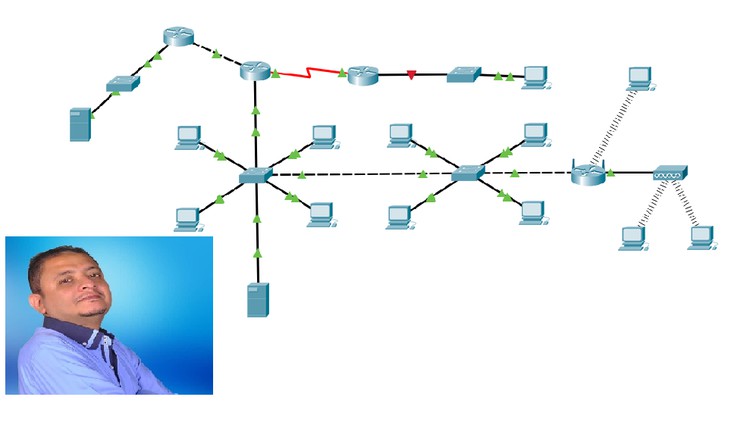***** Very Similar to my INE Course: MTA : Networking Fundamentals (Exam 98-366) *****
When you learn or teach Computer Networking, you might wonder about how topics should be explained. Should theory concepts such as OSI and TCP/IP models be explained first? Then how students will fully understand and comprehend ideas related to these models such as MAC and IP addresses and how they work in networks? Should they try to imagine this in their minds? And if the addressing concepts were explained first, then how can students fully understand these concepts without seeing them in action before moving to other concepts? Here we see that some practice is needed along with the theory explanation of these concepts. And should the students practice with individual mini labs or with full network from the start that would terrify them with its looking? This course progresses through concepts and topics using step-by step theory & project-based logical and systematic methods which is the solution for these issues. Students should learn with a mixture of theory and practice that moves from one topic to another related one while their network or project grows little by little. So as an example for this step-by-step learning method, in the first lectures, you will learn about what is a computer network, and what are local area networks or LANs, since those are the most basic form of a network you will encounter in real world. After that we have to understand network addresses in order to assign them to devices in our network, and thus enable communication between those devices. But before that, we have to understand numbering systems, such as binary and hexadecimal, since network addresses such as IPv4, IPv6, and MAC are implemented using these numbering systems.
Now as you have understood the concepts of network addressing, it is time to practice with them, and we will use Cisco packet Tracer for that purpose. Afterwards, you have to understand how to map between different types of addresses using ARP, or the Address Resolution Protocol, and why this mapping is needed. Also ICMP or the Internet Control Message Protocol will be explained to demonstrate how communication in computer networks works. And again will we practice both ARP and ICMP using Packet Tracer in order to understand the concepts, and start establishing our hands on expertise. The same logical order of topics or lectures will continue to the end of the course. We will use the the MTA: Networking fundamentals curriculum to learn about Computer Networking and build our network through this course.
MTA or Microsoft Technology Associate is an entry-level certification that provides the fundamentals of a certain technology based on Microsoft products. The MTA: Networking Fundamentals (exam 98-366) is one of these certifications that will provide essential networking knowledge and skills to you. This certification can be your first step in networking and towards other advanced Microsoft certifications such as MCSA and MCSE. It can be considered as the Microsoft version of Network+ or Cisco ICND1/CCENT. This course will help you to prepare for this certification through building a network step by step, going from LAN, addressing, switching, topologies, media types, and networking models to WAN, routing, remote access, security, and network services. With each step, you will learn the theory and practical skills related to it.
I hope that you will join me in this course and start your journey of leaning or teaching computer networking. Happy learning and inspirational teaching!
Central Hub
Gather all your networking courses in one organized platform.
Professional Proof
Build an online resume that showcases your skills instantly.
Global Community
Connect with learners worldwide and share insights.
Continuous Growth
Keep learning seamlessly, whenever and wherever.
Organized Learning
Customize your environment to stay focused and clutter-free.
Transformative change
Gain knowledge and skills that reshape your path forward.
Atenea Learning is a centralized platform that helps you organize, access, and succeed in networking courses, with community interactions and tools for professional growth.
There are over 200 networking and professional-development courses ready to enroll.
Yes! You can create a professional online resume to showcase your skills and experience.
Definitely. You’ll be able to interact socially with other learners around the world.
Yes, learning is designed to be continuous and accessible at your convenience, so you can grow at your own pace.
Absolutely. Atenea allows you to organize and tailor your learning environment according to your preferences.
It’s ideal for anyone wanting to advance in networking, build professional credentials, and join a global community of learners.

42,00 €
Teach and learn Computer Networking the proper way using the Microsoft Networking Fundamentals (Exam 98-366) Curriculum